Shweta Mahajan
RoCA: Robust Cross-Domain End-to-End Autonomous Driving
Jun 11, 2025Abstract:End-to-end (E2E) autonomous driving has recently emerged as a new paradigm, offering significant potential. However, few studies have looked into the practical challenge of deployment across domains (e.g., cities). Although several works have incorporated Large Language Models (LLMs) to leverage their open-world knowledge, LLMs do not guarantee cross-domain driving performance and may incur prohibitive retraining costs during domain adaptation. In this paper, we propose RoCA, a novel framework for robust cross-domain E2E autonomous driving. RoCA formulates the joint probabilistic distribution over the tokens that encode ego and surrounding vehicle information in the E2E pipeline. Instantiating with a Gaussian process (GP), RoCA learns a set of basis tokens with corresponding trajectories, which span diverse driving scenarios. Then, given any driving scene, it is able to probabilistically infer the future trajectory. By using RoCA together with a base E2E model in source-domain training, we improve the generalizability of the base model, without requiring extra inference computation. In addition, RoCA enables robust adaptation on new target domains, significantly outperforming direct finetuning. We extensively evaluate RoCA on various cross-domain scenarios and show that it achieves strong domain generalization and adaptation performance.
Distilling Multi-modal Large Language Models for Autonomous Driving
Jan 16, 2025Abstract:Autonomous driving demands safe motion planning, especially in critical "long-tail" scenarios. Recent end-to-end autonomous driving systems leverage large language models (LLMs) as planners to improve generalizability to rare events. However, using LLMs at test time introduces high computational costs. To address this, we propose DiMA, an end-to-end autonomous driving system that maintains the efficiency of an LLM-free (or vision-based) planner while leveraging the world knowledge of an LLM. DiMA distills the information from a multi-modal LLM to a vision-based end-to-end planner through a set of specially designed surrogate tasks. Under a joint training strategy, a scene encoder common to both networks produces structured representations that are semantically grounded as well as aligned to the final planning objective. Notably, the LLM is optional at inference, enabling robust planning without compromising on efficiency. Training with DiMA results in a 37% reduction in the L2 trajectory error and an 80% reduction in the collision rate of the vision-based planner, as well as a 44% trajectory error reduction in longtail scenarios. DiMA also achieves state-of-the-art performance on the nuScenes planning benchmark.
HyperNet Fields: Efficiently Training Hypernetworks without Ground Truth by Learning Weight Trajectories
Dec 22, 2024Abstract:To efficiently adapt large models or to train generative models of neural representations, Hypernetworks have drawn interest. While hypernetworks work well, training them is cumbersome, and often requires ground truth optimized weights for each sample. However, obtaining each of these weights is a training problem of its own-one needs to train, e.g., adaptation weights or even an entire neural field for hypernetworks to regress to. In this work, we propose a method to train hypernetworks, without the need for any per-sample ground truth. Our key idea is to learn a Hypernetwork `Field` and estimate the entire trajectory of network weight training instead of simply its converged state. In other words, we introduce an additional input to the Hypernetwork, the convergence state, which then makes it act as a neural field that models the entire convergence pathway of a task network. A critical benefit in doing so is that the gradient of the estimated weights at any convergence state must then match the gradients of the original task -- this constraint alone is sufficient to train the Hypernetwork Field. We demonstrate the effectiveness of our method through the task of personalized image generation and 3D shape reconstruction from images and point clouds, demonstrating competitive results without any per-sample ground truth.
DDIL: Improved Diffusion Distillation With Imitation Learning
Oct 15, 2024Abstract:Diffusion models excel at generative modeling (e.g., text-to-image) but sampling requires multiple denoising network passes, limiting practicality. Efforts such as progressive distillation or consistency distillation have shown promise by reducing the number of passes at the expense of quality of the generated samples. In this work we identify co-variate shift as one of reason for poor performance of multi-step distilled models from compounding error at inference time. To address co-variate shift, we formulate diffusion distillation within imitation learning (DDIL) framework and enhance training distribution for distilling diffusion models on both data distribution (forward diffusion) and student induced distributions (backward diffusion). Training on data distribution helps to diversify the generations by preserving marginal data distribution and training on student distribution addresses compounding error by correcting covariate shift. In addition, we adopt reflected diffusion formulation for distillation and demonstrate improved performance, stable training across different distillation methods. We show that DDIL consistency improves on baseline algorithms of progressive distillation (PD), Latent consistency models (LCM) and Distribution Matching Distillation (DMD2).
Visual Concept-driven Image Generation with Text-to-Image Diffusion Model
Feb 18, 2024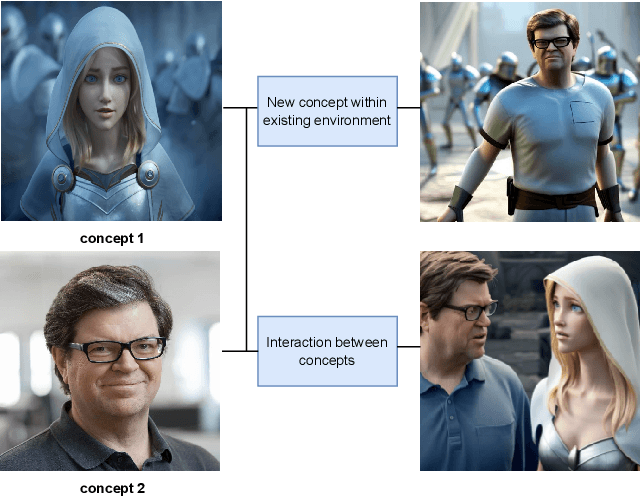



Abstract:Text-to-image (TTI) diffusion models have demonstrated impressive results in generating high-resolution images of complex and imaginative scenes. Recent approaches have further extended these methods with personalization techniques that allow them to integrate user-illustrated concepts (e.g., the user him/herself) using a few sample image illustrations. However, the ability to generate images with multiple interacting concepts, such as human subjects, as well as concepts that may be entangled in one, or across multiple, image illustrations remains illusive. In this work, we propose a concept-driven TTI personalization framework that addresses these core challenges. We build on existing works that learn custom tokens for user-illustrated concepts, allowing those to interact with existing text tokens in the TTI model. However, importantly, to disentangle and better learn the concepts in question, we jointly learn (latent) segmentation masks that disentangle these concepts in user-provided image illustrations. We do so by introducing an Expectation Maximization (EM)-like optimization procedure where we alternate between learning the custom tokens and estimating masks encompassing corresponding concepts in user-supplied images. We obtain these masks based on cross-attention, from within the U-Net parameterized latent diffusion model and subsequent Dense CRF optimization. We illustrate that such joint alternating refinement leads to the learning of better tokens for concepts and, as a bi-product, latent masks. We illustrate the benefits of the proposed approach qualitatively and quantitatively (through user studies) with a number of examples and use cases that can combine up to three entangled concepts.
Prompting Hard or Hardly Prompting: Prompt Inversion for Text-to-Image Diffusion Models
Dec 19, 2023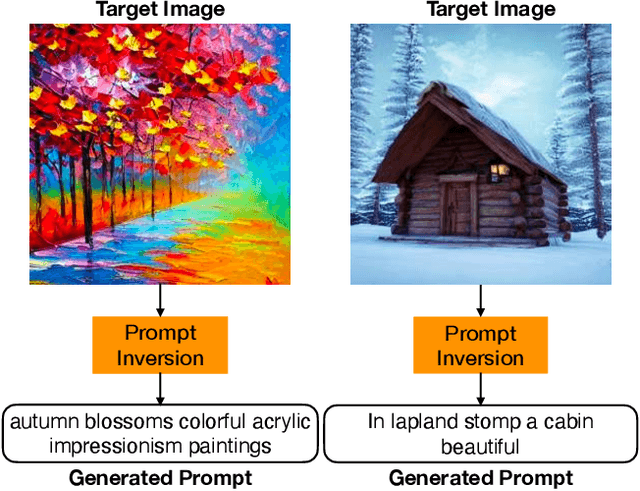


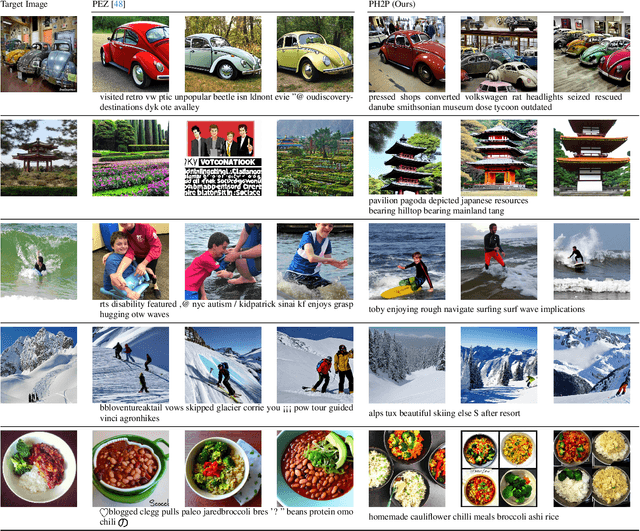
Abstract:The quality of the prompts provided to text-to-image diffusion models determines how faithful the generated content is to the user's intent, often requiring `prompt engineering'. To harness visual concepts from target images without prompt engineering, current approaches largely rely on embedding inversion by optimizing and then mapping them to pseudo-tokens. However, working with such high-dimensional vector representations is challenging because they lack semantics and interpretability, and only allow simple vector operations when using them. Instead, this work focuses on inverting the diffusion model to obtain interpretable language prompts directly. The challenge of doing this lies in the fact that the resulting optimization problem is fundamentally discrete and the space of prompts is exponentially large; this makes using standard optimization techniques, such as stochastic gradient descent, difficult. To this end, we utilize a delayed projection scheme to optimize for prompts representative of the vocabulary space in the model. Further, we leverage the findings that different timesteps of the diffusion process cater to different levels of detail in an image. The later, noisy, timesteps of the forward diffusion process correspond to the semantic information, and therefore, prompt inversion in this range provides tokens representative of the image semantics. We show that our approach can identify semantically interpretable and meaningful prompts for a target image which can be used to synthesize diverse images with similar content. We further illustrate the application of the optimized prompts in evolutionary image generation and concept removal.
Unsupervised Keypoints from Pretrained Diffusion Models
Dec 05, 2023



Abstract:Unsupervised learning of keypoints and landmarks has seen significant progress with the help of modern neural network architectures, but performance is yet to match the supervised counterpart, making their practicability questionable. We leverage the emergent knowledge within text-to-image diffusion models, towards more robust unsupervised keypoints. Our core idea is to find text embeddings that would cause the generative model to consistently attend to compact regions in images (i.e. keypoints). To do so, we simply optimize the text embedding such that the cross-attention maps within the denoising network are localized as Gaussians with small standard deviations. We validate our performance on multiple datasets: the CelebA, CUB-200-2011, Tai-Chi-HD, DeepFashion, and Human3.6m datasets. We achieve significantly improved accuracy, sometimes even outperforming supervised ones, particularly for data that is non-aligned and less curated. Our code is publicly available and can be found through our project page: https://ubc-vision.github.io/StableKeypoints/
ViVid-1-to-3: Novel View Synthesis with Video Diffusion Models
Dec 03, 2023Abstract:Generating novel views of an object from a single image is a challenging task. It requires an understanding of the underlying 3D structure of the object from an image and rendering high-quality, spatially consistent new views. While recent methods for view synthesis based on diffusion have shown great progress, achieving consistency among various view estimates and at the same time abiding by the desired camera pose remains a critical problem yet to be solved. In this work, we demonstrate a strikingly simple method, where we utilize a pre-trained video diffusion model to solve this problem. Our key idea is that synthesizing a novel view could be reformulated as synthesizing a video of a camera going around the object of interest -- a scanning video -- which then allows us to leverage the powerful priors that a video diffusion model would have learned. Thus, to perform novel-view synthesis, we create a smooth camera trajectory to the target view that we wish to render, and denoise using both a view-conditioned diffusion model and a video diffusion model. By doing so, we obtain a highly consistent novel view synthesis, outperforming the state of the art.
Unsupervised Semantic Correspondence Using Stable Diffusion
May 24, 2023Abstract:Text-to-image diffusion models are now capable of generating images that are often indistinguishable from real images. To generate such images, these models must understand the semantics of the objects they are asked to generate. In this work we show that, without any training, one can leverage this semantic knowledge within diffusion models to find semantic correspondences -- locations in multiple images that have the same semantic meaning. Specifically, given an image, we optimize the prompt embeddings of these models for maximum attention on the regions of interest. These optimized embeddings capture semantic information about the location, which can then be transferred to another image. By doing so we obtain results on par with the strongly supervised state of the art on the PF-Willow dataset and significantly outperform (20.9% relative for the SPair-71k dataset) any existing weakly or unsupervised method on PF-Willow, CUB-200 and SPair-71k datasets.
Make-A-Story: Visual Memory Conditioned Consistent Story Generation
Nov 23, 2022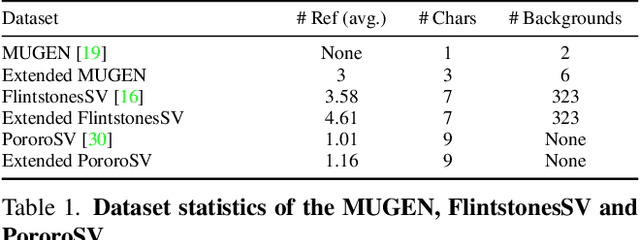


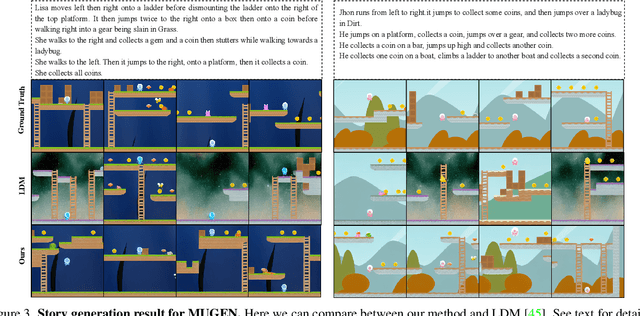
Abstract:There has been a recent explosion of impressive generative models that can produce high quality images (or videos) conditioned on text descriptions. However, all such approaches rely on conditional sentences that contain unambiguous descriptions of scenes and main actors in them. Therefore employing such models for more complex task of story visualization, where naturally references and co-references exist, and one requires to reason about when to maintain consistency of actors and backgrounds across frames/scenes, and when not to, based on story progression, remains a challenge. In this work, we address the aforementioned challenges and propose a novel autoregressive diffusion-based framework with a visual memory module that implicitly captures the actor and background context across the generated frames. Sentence-conditioned soft attention over the memories enables effective reference resolution and learns to maintain scene and actor consistency when needed. To validate the effectiveness of our approach, we extend the MUGEN dataset and introduce additional characters, backgrounds and referencing in multi-sentence storylines. Our experiments for story generation on the MUGEN and the FlintstonesSV dataset show that our method not only outperforms prior state-of-the-art in generating frames with high visual quality, which are consistent with the story, but also models appropriate correspondences between the characters and the background.
 Add to Chrome
Add to Chrome Add to Firefox
Add to Firefox Add to Edge
Add to Edge